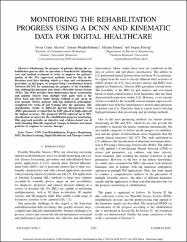| dc.contributor.author | Alcaraz, Javier Conte | |
| dc.contributor.author | Moghaddamnia, Sanam | |
| dc.contributor.author | Penner, Maxim | |
| dc.contributor.author | Peissig, Jürgen | |
| dc.date.accessioned | 2021-05-17T09:07:29Z | |
| dc.date.available | 2021-05-17T09:07:29Z | |
| dc.date.issued | 2021 | en_US |
| dc.identifier.citation | Alcaraz, J. C., Moghaddamnia, S., Penner, M., & Peissig, J. (2021). Monitoring the Rehabilitation Progress Using a DCNN and Kinematic Data for Digital Healthcare. In 2020 28th European Signal Processing Conference (EUSIPCO) (pp. 1333-1337). IEEE. | en_US |
| dc.identifier.uri | https://hdl.handle.net/20.500.12846/585 | |
| dc.description.abstract | Monitoring the progress of patients during the rehabilitation process after an operation is beneficial for adjusting care and medical treatment in order to improve the patient's quality of life. The supervised methods used for this in the literature need data labeling, which is a time and cost-intensive procedure. In this paper, we propose Deep Convolutional Neural Network (DCNN) for monitoring the progress of the rehabilitation, utilizing the kinematic data from a Wearable Sensor System (WSS). The WSS provides three-dimensional linear acceleration and angular velocity from multiple body parts such as the lower back and lower limbs during walking at any speed on level ground. Twelve patients with hip unilateral arthroplasty completed two weeks of gait training after the operation. The classification results of different Inertial Measurement Unit (IMU) placements revealed that the IMU placed at thigh achieved the highest accuracy. The proposed DCNN achieved up to 98% classification accuracy for the rehabilitation progress monitoring. This approach provides an objective and evidence-based way of understanding clinically important changes in human movement patterns in response to exercise therapy. | en_US |
| dc.language.iso | eng | en_US |
| dc.publisher | Institute of Electrical and Electronics Engineers | en_US |
| dc.relation.isversionof | 10.23919/Eusipco47968.2020.9287324 | en_US |
| dc.rights | info:eu-repo/semantics/closedAccess | en_US |
| dc.subject | Gait Rehabilitation | en_US |
| dc.subject | Progress Monitoring | en_US |
| dc.subject | Machine Learning | en_US |
| dc.subject | Digital Healthcare and Therapy Control | en_US |
| dc.subject | Yürüyüş Rehabilitasyonu | en_US |
| dc.subject | Dijital Sağlık ve Terapi Kontrolü | en_US |
| dc.subject | Gangrehabilitation | en_US |
| dc.subject | Fortschrittsüberwachung | en_US |
| dc.subject | Maschinelles Lernen | en_US |
| dc.subject | Digitale Gesundheits- und Therapiekontrolle | en_US |
| dc.title | Monitoring the rehabilitation progress using a DCNN and kinematic data for digital healthcare | en_US |
| dc.type | conferenceObject | en_US |
| dc.relation.journal | 28th European Signal Processing Conference (EUSIPCO 2020) | en_US |
| dc.contributor.authorID | 0000-0002-4916-1898 | en_US |
| dc.relation.publicationcategory | Konferans Öğesi - Uluslararası - Kurum Öğretim Elemanı | en_US |
| dc.contributor.department | TAÜ, Mühendislik Fakültesi, Elektrik-Elektronik Mühendisliği Bölümü | en_US |
| dc.contributor.institutionauthor | Moghaddamnia, Sanam | |
| dc.identifier.startpage | 1333 | en_US |
| dc.identifier.endpage | 1337 | en_US |
| dc.identifier.wosquality | N/A | en_US |
| dc.identifier.scopusquality | N/A | en_US |

















